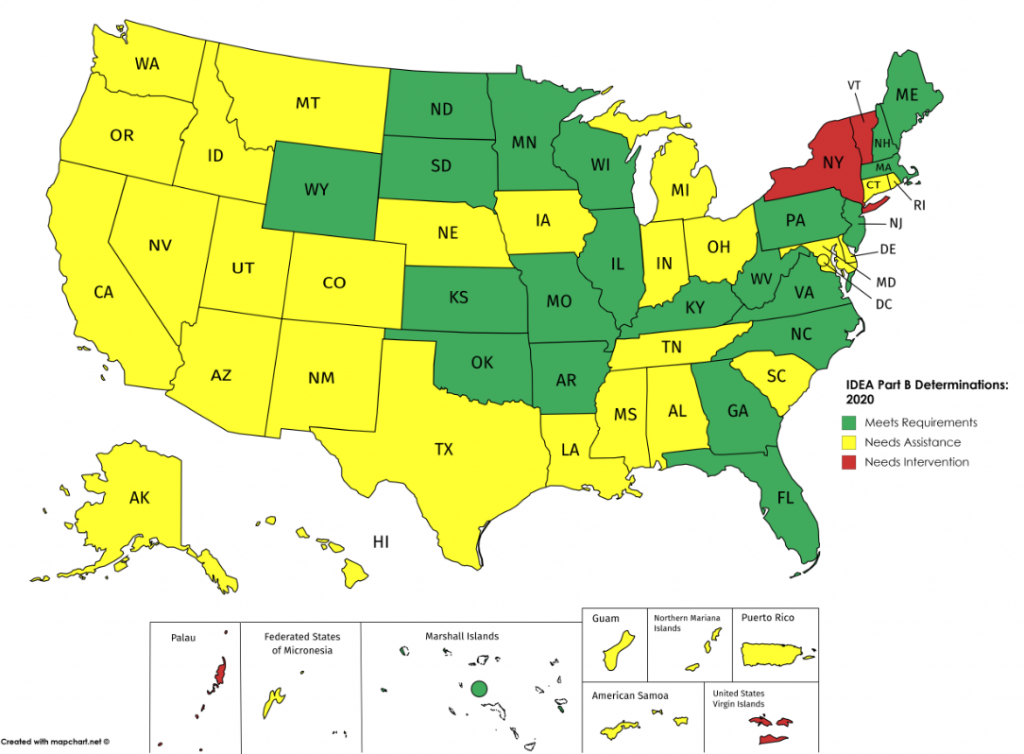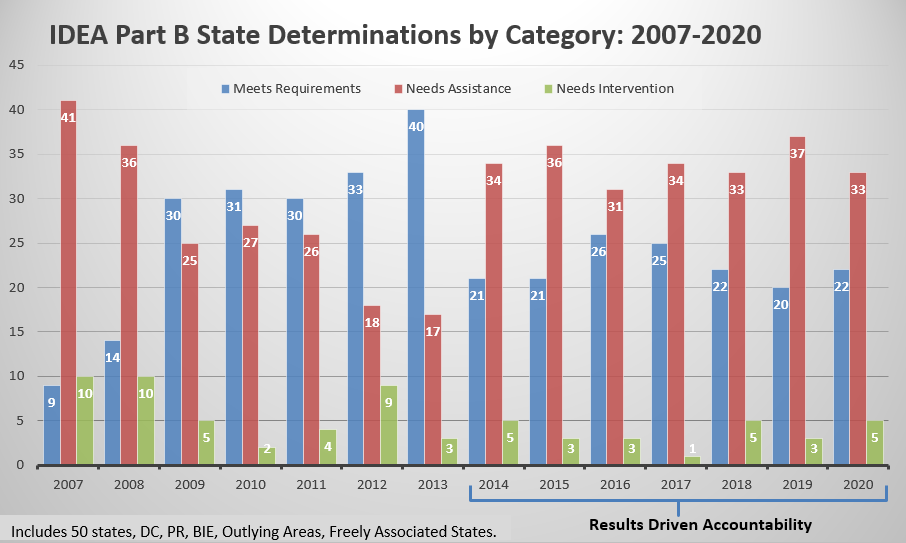How the States Stack Up: 2020 IDEA Determinations
In June 2020 the U.S. Dept. of Education (ED) Office of Special Education Programs (OSEP) released the annual state determinations. The Individuals with Disabilities Education Act (IDEA) requires ED to annually assign every state a “rating” on its implementation of IDEA, based on the state’s performance on its State Performance Plan (SPP). The 2020 determinations are based on performance for fiscal year 2018. Each state is assigned one of the following ratings:
– Meets requirements and purposes of the IDEA Part B
– Needs assistance in implementing the requirements of IDEA Part B
– Needs intervention in implementing the requirements of IDEA Part B
– Needs substantial intervention in implementing the requirements of IDEA Part B
The map below shows the 2020 rating for each state.

The method for determining the rating is described in these documents:
– IDEA Determinations Fact Sheet
– How the Department Made Determinations – Part B
Here is how to locate information for your state’s 2020 rating:
– Go to this page
– Locate your state’s 2020 SPP/APR and State Determination Letters PART B
– Click and download the MS WORD document of the 2020 SPP/APR Submission PART B
– Go to the end of the MS WORD document and click on the PDF icon that says “results matrix 2020 part B.” This document – titled “2020 Part B Results-Driven Accountability Matrix” – provides the scoring for each element of the matrix used to determine the state’s rating.
Now for the value of the “Results-Driven Accountability (RDA) Matrix. We have spent a great deal of time examining RDA. Our critique of the current RDA process, introduced in 2014, is examined in depth in this report, “Results Driven Accountability Needs Substantial Intervention.” We discuss in detail what’s working and not working after several years of RDA-based state determinations. As the chart below shows, the number of states earning a “Meets Requirements” rating has not improved under RDA. Get ratings by state from 2014-2020 here. (PDF, 1 pg)

While OSEP announced that it would make substantial changes to the RDA determinations process in the determination letters sent to states back in 2019 (see note below), ultimately the same process was used to make the 2020 determinations.
We continue to hope for substantial changes to RDA – changes that would result in improved outcomes for students with disabilities.
Stay tuned.
See also:
Federal Monitoring and Enforcement of IDEA Compliance, National Council on Disability, 2018
NB: The 2019 determination letters included this notice:
“The Secretary is considering modifying the factors the Department will use in making its determinations in June 2020 as part of its continuing emphasis on results for children with disabilities. Section 616(a)(2) of the IDEA requires that the primary focus of IDEA monitoring must be on improving educational results and functional outcomes for all children with disabilities, and ensuring that States meet the IDEA program requirements, with an emphasis on those requirements that are most closely related to improving educational results for children with disabilities.
The proposed Part B determinations process will include the same compliance factors as in past years, with one addition. For the 2020 determinations, rather than weighting each compliance factor equally, OSEP is considering assigning greater weight to those compliance factors most directly related to improving results for children with disabilities. For the 2020 determinations process we are also considering, as two additional results factors, State-reported data on: preschool child outcomes and the State Systemic Improvement Plan (SSIP). Using preschool outcomes for Part B determinations is consistent with the use of the early childhood outcomes factor that has been used for Part C determinations since 2015. Use of this factor emphasizes the importance of preschool outcomes in promoting later school success for students with disabilities. The inclusion of the SSIP as a results factor in making determinations would continue OSEP’s emphasis on incorporating a results-driven approach as States identify evidence-based practices that lead to improved outcomes for children and youth with disabilities. In addition, we are considering several changes to the results factors related to the participation and performance of children with disabilities on assessments, including: (1) using Statewide assessment results, rather than the NAEP performance data; (2) looking at year-to-year improvements in Statewide assessment results and taking into account the full Statewide assessment system, including alternate assessments; and (3) no longer comparing each State’s assessment performance with that of other States. Finally, OSEP will be revisiting ways of measuring improvement in the graduation rate of students with disabilities. As we consider changes to how we use the data under these factors in making the Department’s 2020 determinations, OSEP will provide parents, States, entities, LEAs, and other stakeholders with an opportunity to comment and provide input through OSEP’s Leadership Conference in July 2019 and other meetings.”